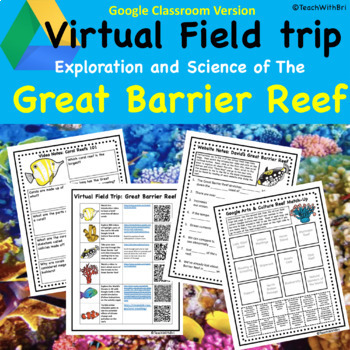FREE The Great Barrier Reef Virtual Field Trip for Google Classroom
- Google Drive™ folder

Description
Dive in to explore the Great Barrier Reef, no goggles required! Learn about coral bleaching, fish species, turtles, Australia and this famous reef, global warming effects, and more in this exciting sea and ocean lesson! Perfect for middle, high school, and upper elementary grades!
Take a Virtual Field Trip:
- Watch a 360 dive of the Great Barrier Reef
- Explore in VR with Google Earth Tour of the Reef in 360
- Explore readings in an interactive 360 Map of the Great Barrier Reef
- Watch a video about the science of the reef
- Try an online global ocean warming simulator
This is the digital version meant for use with Google Classroom and Google Apps. To find this same exciting resource in PDF printable form (ideal for shared device classrooms or using at one screen in the front of the classroom) please see my store TeachWithBri
This product includes all of the following plus more:
- Free product code for teachers (a 2 Dollar Value from my store)
- Teacher instructions
- Differentiation ideas for students
- Essential questions for lessons (can be posted throughout lesson or given as an assignment task for students) Questions align to Bloom's Taxonomy Levels
- Student instructions
- Virtual Field Trip go page (links to field trip activities) lots of great links with QR!
- Field trip overview summary worksheet page (before attending page)
- Pre-assessment True or False student learning check
- Video questions page about the Great Barrier Reef
- Question observation page- Great Barrier Reef 360 Explorations
- Website note taking fill in the blank worksheet for the Reef
- Explorations of the Reef worksheet activity
- Video tour of the Great Barrier Reef
- Video questions- Dive the Great Barrier Reef
- Assessment (field trip check)
- Compare the Reef now and then Venn Diagram
- Writing task- newspaper article about warming on the corals
- Website notes- Fill in the blank
- Parts of the Reef location match-up task
- Creation of a more resistant reef task application task
- Snapshots of the Great Barrier Reef creative assignment
- Writing summarization task- postcard writing from an ocean zone
- Summary worksheet page
- Assessment of learning (5 question quiz page for students)
- Grading Rubric for teachers
- Student self assessment grading rubric
- True or False learning check (for students to post assess learning)
- Teacher Assessment key
- Teacher true or false answer key
- Video questions answer key for teachers
- Website questions match key for teachers
- More Answer Keys
- Terms of use and credit pages
- Connect with me for more pages!
All of my lessons are designed to work through the levels of learning according to Bloom's Taxonomy. Lessons start with information given to students through field trip links and then student learning works through the Bloom's levels to help guide and build learning. Students first show knowledge with basic recall questions from video answer question worksheets. Next students demonstrate comprehension by retelling key ideas with guided worksheet questions. Application is included with allowing students the opportunity to show what they have learned in worksheet tasks. Next students move to the analysis then synthesis stage of Bloom's Taxonomy by creating and synthesizing their own products or inventing using what they learned. Last students evaluate by both evaluating the content they created with specifically designed worksheets then evaluating their own work with self-assessment opportunity included.
Check out a freebie from this series and other great freebies from my store to see the types of activities included in virtual field trips.
Love this lesson? Be sure to check out more great resources from my store and FOLLOW ME FOR WEEKLY FREEBIES! (That's right, I strive to post a new free product each and every week, so be sure to click the star to follow me above!) Follow along with my lessons and see great learning in action on Pinterest at TEACHWITHBRI12
*Please note the places in this exciting field trip are in no way associated with TeachwithBri or TeachersPayTeachers and are independent great places and sites. They are meant to be used as a resource with the exciting lessons and activities in this product and are in no way my own work or property.





